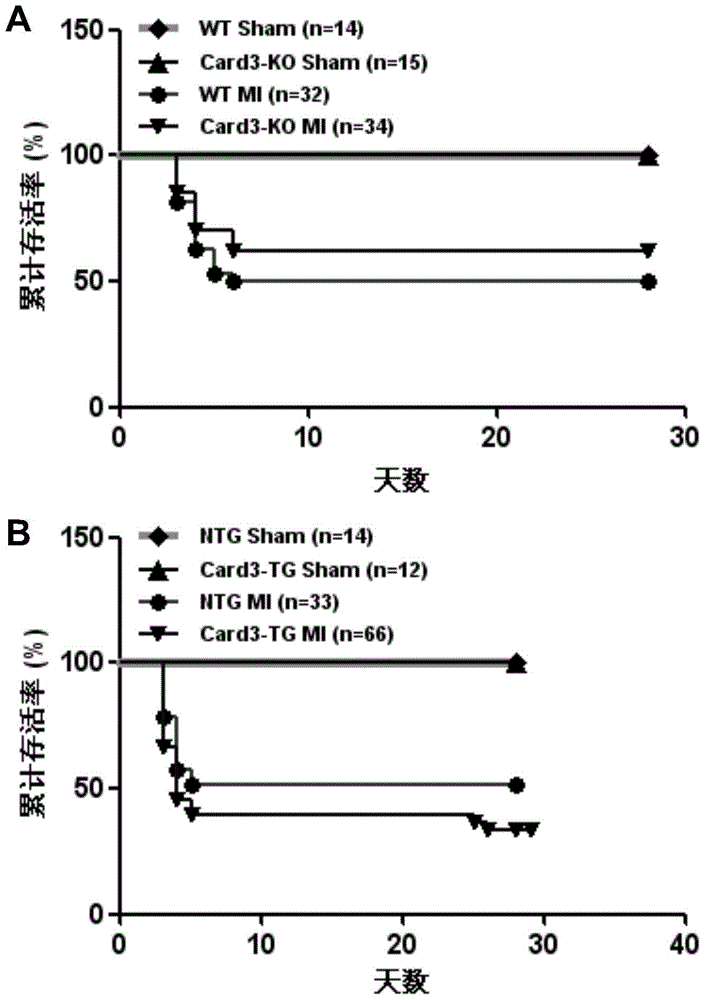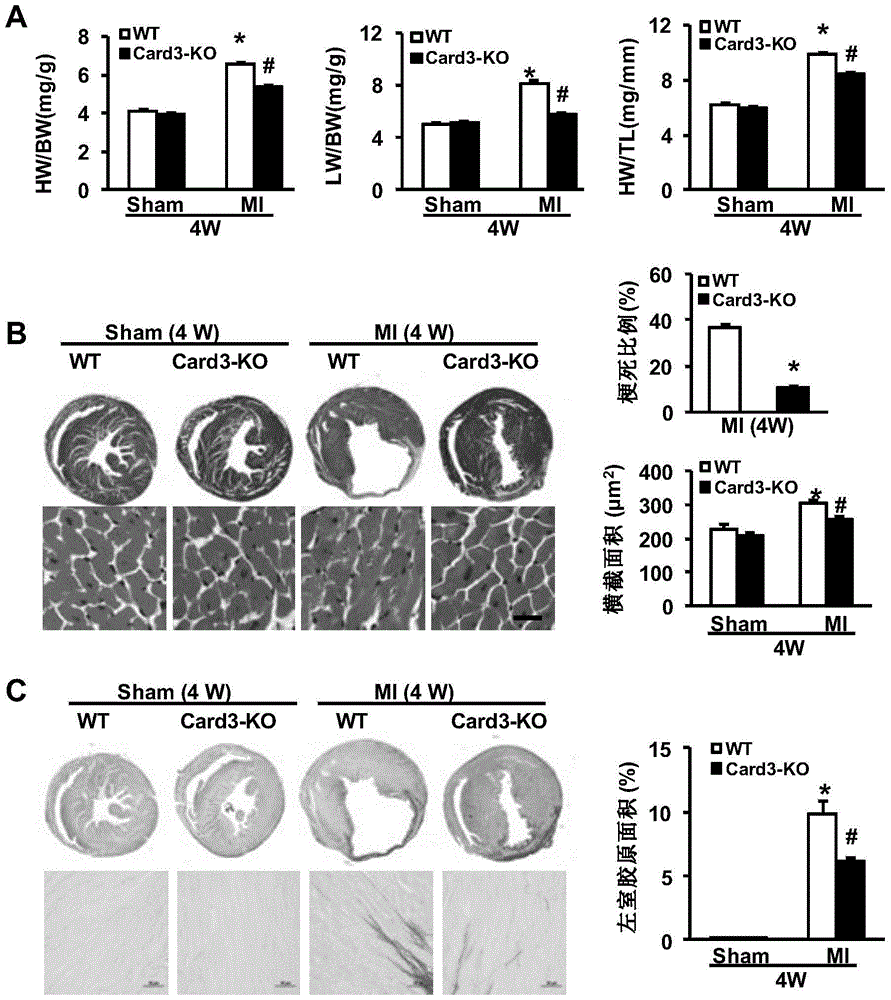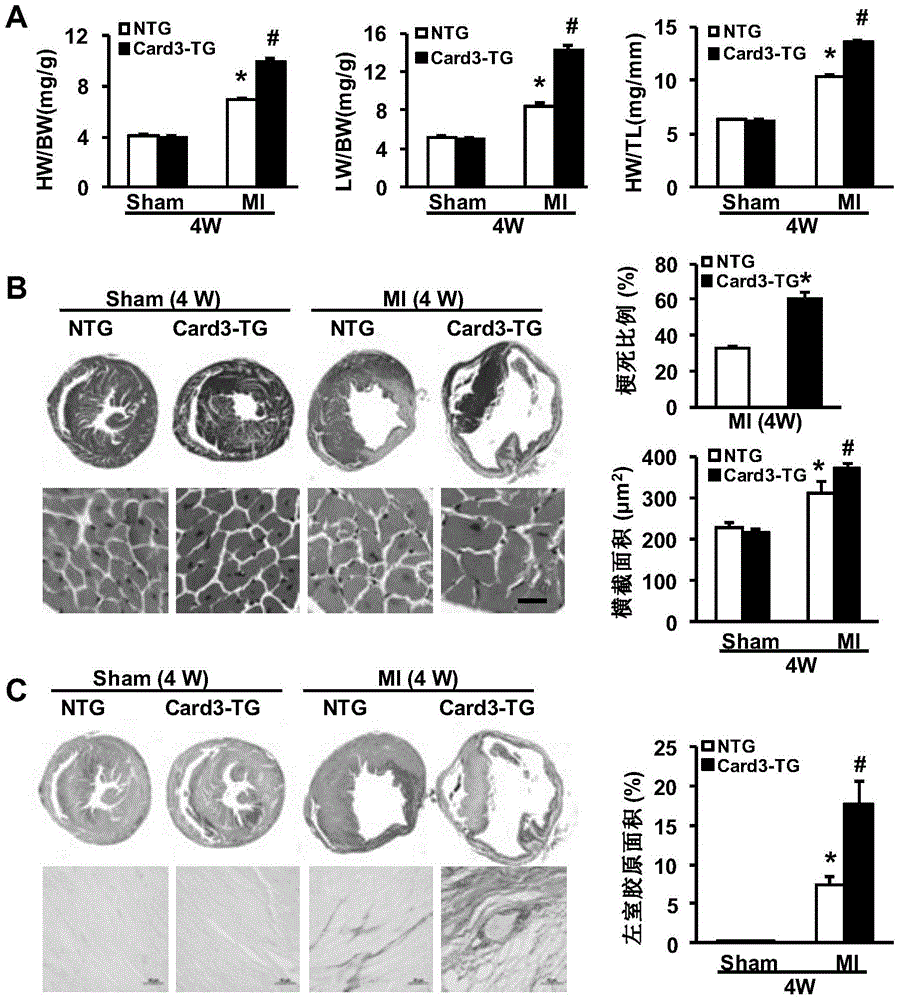Function and application of caspase activation and recruitment binding domain 3 (card3) gene in coronary atherosclerotic heart disease
A technology of coronary atherosclerosis and binding domains, applied in gene therapy, cardiovascular system diseases, medical preparations containing active ingredients, etc., can solve problems such as death, arrhythmia, and cardiac insufficiency
- Summary
- Abstract
- Description
- Claims
- Application Information
AI Technical Summary
Problems solved by technology
Method used
Image
Examples
Embodiment 1
[0033] [Example 1] Myocardial infarction (MI) model acquisition
[0034] 1. Grouping of experimental animals: male C57BL / 6 background WT mice, Card3 knockout mice (Card3-KO), heart-specific Card3 transgenic mice (Card3-TG) and non-transgenic mice (NTG), by ligation A mouse model of myocardial infarction (MI) caused by the left anterior descending coronary artery (LAD). Randomly divided into 8 groups, each group: C57BL / 6 background WT mice sham operation group (WT Sham) and MI operation group (WT MI), Card3 gene knockout mouse sham operation group (Card3-KO Sham) and MI operation group group (Card3-KO MI), non-transgenic mouse sham operation group (NTG Sham) and MI operation group (NTG MI), heart-specific Card3 transgenic mouse sham operation group (Card3-TG Sham) and MI operation group (Card3 -TG MI).
[0035] 2. The MI model uses blocking the left anterior descending coronary artery (LAD) of the mouse heart to cause myocardial infarction. The operation process of the model ...
Embodiment 2
[0044] [Example 2] Detection of myocardial infarction ratio, myocardial hypertrophy and fibrosis in mouse myocardial infarction (MI) model
[0045] 1. Collect materials
[0046] (1) Preliminary work: prepare a urine cup filled with 20mL of 10% formaldehyde in advance, and label it (mouse number, group, type of operation and date of collection). Place the petri dish filled with 10% KCl solution at the sampling site. Turn on the analytical balance, adjust to zero, and then weigh and kill the mice.
[0047] (2) Material collection: Ophthalmic curved forceps clamped the vascular pedicle below the atrial appendage, cut off the heart, and quickly placed it in 10% KCl solution. After the heart stops beating in the diastolic phase, place it on sterilized gauze, gently squeeze the fluid in the heart cavity, dip the surface fluid dry, weigh and record, put the heart into the corresponding urine cup, fix it for 48 hours and use it for pathological testing.
[0048] (3) Relevant measu...
Embodiment 3
[0067] [Example 3] Detection of cardiac function in myocardial infarction (MI) model mice
[0068] 1 Ultrasound detection of cardiac function
[0069] 1.1 Early preparations
[0070] (1) Anesthesia machine preparation: first connect the oxygen cylinder and the air inlet port on the anesthesia machine, then unscrew the sealing cap of the dosing port on the anesthesia machine, quickly add isoflurane to the safety scale, and then tighten the sealing cap. Unscrew the main valve on the oxygen cylinder, adjust the knob of the flow control valve, and maintain the outlet pressure at 0.2-0.3mPa.
[0071] (2) Preparation of the mice to be tested: After the mice to be tested were quickly anesthetized with isoflurane, the hair on the left chest area was shaved, and the head of the treated mice was inserted into the anesthetic catheter sleeve, and treated with 1.5-2.0% isoflurane Alkane maintains a stable anesthesia in mice.
[0072] 1.2 Cardiac function test
[0073] The mice were pla...
PUM
 Login to View More
Login to View More Abstract
Description
Claims
Application Information
 Login to View More
Login to View More - R&D
- Intellectual Property
- Life Sciences
- Materials
- Tech Scout
- Unparalleled Data Quality
- Higher Quality Content
- 60% Fewer Hallucinations
Browse by: Latest US Patents, China's latest patents, Technical Efficacy Thesaurus, Application Domain, Technology Topic, Popular Technical Reports.
© 2025 PatSnap. All rights reserved.Legal|Privacy policy|Modern Slavery Act Transparency Statement|Sitemap|About US| Contact US: help@patsnap.com



